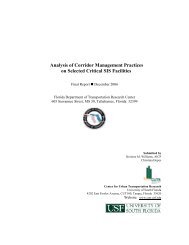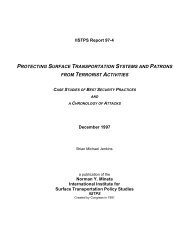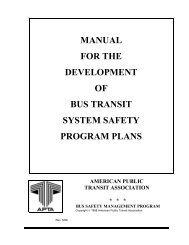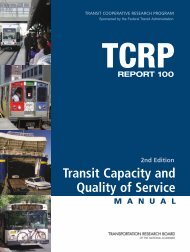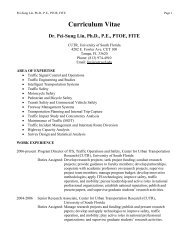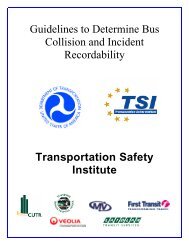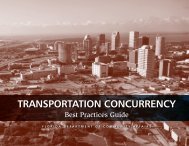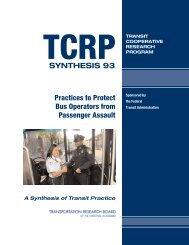a technical guide for conducting pedestrian safety assessments
a technical guide for conducting pedestrian safety assessments
a technical guide for conducting pedestrian safety assessments
Create successful ePaper yourself
Turn your PDF publications into a flip-book with our unique Google optimized e-Paper software.
UNIVERSITY OF CALIFORNIA BERKELEY • INSTITUTE OF TRANSPORTATION STUDIES • TECHNOLOGY TRANSFER PROGRAM<br />
55<br />
APPENDIX C<br />
WALK SCORE<br />
A Walk Score may be obtained from the website www.walkscore.com. The score offers an objective, quantitative<br />
method <strong>for</strong> assessing the walkability of an area based on nearby stores, restaurants, schools, parks, etc. The score is a<br />
number between 0 and 100 that may be interpreted as follows:<br />
➜ 90 - 100 = Walkers' Paradise: Most errands can be accomplished on foot and many people get by without<br />
owning a car.<br />
➜ 70 - 90 = Very Walkable: It's possible to get by without owning a car.<br />
➜ 50 - 70 = Some Walkable Locations: Some stores and amenities are within walking distance, but many everyday<br />
trips still require a bike, public transportation, or car.<br />
➜ 25 - 50 = Not Walkable: Only a few destinations are within easy walking range. For most errands, driving or public<br />
transportation is a must.<br />
➜ 0 - 25 = Driving Only: Virtually no neighborhood destinations within walking range. You can walk from your house to<br />
your car!<br />
The score is calculated based on:<br />
➜ The distance to walkable locations near an address.<br />
➜ Calculating a score <strong>for</strong> each of these locations.<br />
➜ Combining these scores into one easy to read Walk Score.<br />
In the current version, however, the score does not include many variables such as:<br />
➜ Street width and block length: Narrow streets slow down traffic. Short blocks make it easier to navigate the grid.<br />
➜ Safety: How much crime is in the neighborhood? How many traffic [crashes] are there? Are crosswalks well marked<br />
and streets well lit?<br />
➜ Pedestrian-friendly design: Are there walking paths? Are buildings close to the sidewalk with parking in back? Are<br />
sidewalks shaded by trees?<br />
➜ Topography: Hills can make walking difficult, especially if you're carrying groceries.<br />
➜ Public transit: Good public transit is important <strong>for</strong> walkable neighborhoods.<br />
➜ Freeways and bodies of water: Freeways can divide neighborhoods. ...<br />
➜ Weather: In some places it's just too hot or cold to walk regularly.<br />
Sources: http://www.walkscore.com/how-it-works.shtml and http://www.walkscore.com/how-it-doesnt-work.shtml



